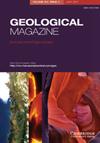伊朗NW sanandaji - sirjan带铁镁质铝质花岗岩地球化学及Sr-Nd同位素特征:晚侏罗世挤压-伸展环境下的花岗岩形成
IF 2
3区 地球科学
Q3 GEOSCIENCES, MULTIDISCIPLINARY
引用次数: 0
摘要
摘要Almogholagh–Dehgolan地区位于伊朗西北部的北萨南达杰–锡尔詹地区。该地区的花岗岩为金属铝质,具有铁系(A型)和I型之间过渡花岗岩的地球化学和结构特征。在大地构造判别图中,Almogholagh–Dehgolan花岗岩主要分布在板内花岗岩和火山弧花岗岩区。除了Qalaylan花岗岩外,其他花岗岩的部分类似于A2型花岗岩。Qalaylan侵入体的花岗岩具有接近I型花岗岩的岩石学和地球化学特征,而不是A型花岗岩。初级地幔和球粒陨石归一化蜘蛛图显示了轻稀土元素相对于重稀土元素的富集。对于150 Ma的年龄,87Sr/86Sr和143Nd/144Nd的初始比值分别在0.702769至0.706545和0.512431至0.512558之间变化。Epsilon Nd值在-0.3和+2.2之间的相对有限的范围内变化,这对应于地幔-地壳混合源。在新的地球化学和同位素数据的基础上,我们提出了一个地球动力学模型,该模型涉及在弱伸展构造环境中地幔岩浆对该地区a型花岗岩生成的贡献下地壳岩石的部分熔融。Sanandaj–Sirjan带这一区域铁磁性(A型)花岗岩的出现表明,在晚侏罗纪时期,在主要与挤压-俯冲相关的机制中,存在部分伸展的构造环境。本文章由计算机程序翻译,如有差异,请以英文原文为准。
Geochemistry and Sr–Nd isotopic characteristics of ferroan-magnesian metaluminous granites of the NW Sanandaj–Sirjan zone, Iran: granite formation in a compressional–extensional setting during Late Jurassic time
Abstract The Almogholagh–Dehgolan region is in the North Sanandaj–Sirjan zone of NW Iran. The granites of the region are metaluminous and display geochemical and textural characteristics of transitional granites between ferroan (A-type) and I-type granites. In geotectonic discrimination diagrams, the Almogholagh–Dehgolan granites plot mainly in the fields of within-plate granites and volcanic arc granites. With the exception of the Qalaylan granites, parts of other granites resemble A2-type granites. Granites of the Qalaylan intrusive body have petrographic and geochemical features close to I-type granites and are not A-type. Primary mantle and chondrite-normalized spider diagrams show enrichments in light rare earth elements relative to heavy rare earth elements. For an age of 150 Ma, the initial 87Sr/86Sr and 143Nd/144Nd ratios vary from 0.702769 to 0.706545 and from 0.512431 to 0.512558, respectively. Epsilon Nd values vary in a relatively limited range between −0.3 and +2.2, which corresponds to a mixed mantle–crustal source. On the basis of new geochemical and isotopic data, we suggest a geodynamic model involving partial melting of lower crustal rocks with the contribution of mantle magmas in a weakly extensional tectonic setting for the generation of the A-type granites of the region. The occurrence of ferroan (A-type) granites in this region of the Sanandaj–Sirjan zone indicates the existence of a partly extensional tectonic environment in a mainly compressional subduction-related regime in Late Jurassic time.
求助全文
通过发布文献求助,成功后即可免费获取论文全文。
去求助
来源期刊

Geological Magazine
地学-地球科学综合
CiteScore
4.70
自引率
0.00%
发文量
111
审稿时长
3 months
期刊介绍:
Geological Magazine, established in 1864, is one of the oldest and best-known periodicals in earth sciences. It publishes original scientific papers covering the complete spectrum of geological topics, with high quality illustrations. Its worldwide circulation and high production values, combined with Rapid Communications and Book Review sections keep the journal at the forefront of the field.
This journal is included in the Cambridge Journals open access initiative, Cambridge Open Option.
 求助内容:
求助内容: 应助结果提醒方式:
应助结果提醒方式:


